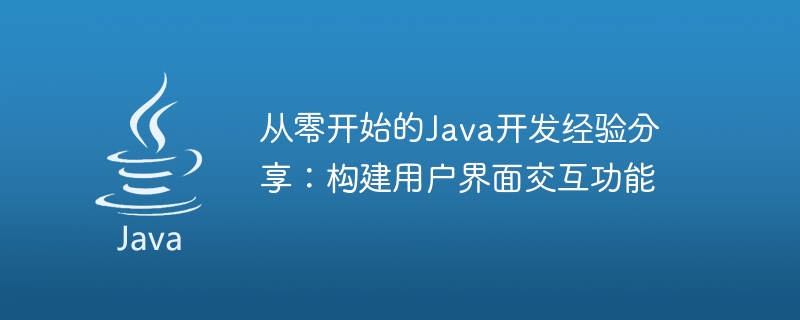

Sharing Java development experience from scratch: building user interface interactive functions
As a language widely used in software development, Java has the characteristics of high performance and cross-functionality. Platform and other features make it popular among developers. In Java development, building user interface interactive functions is an important task. This article will share Java development experience from scratch, focus on how to build user interface interactive functions, and help readers better understand and use Java development technology.
First of all, we need to choose suitable Java development tools. Commonly used Java development tools include Eclipse, IntelliJ IDEA, etc. These development tools integrate rich functions that can greatly improve development efficiency. It is very important to choose a development tool that suits you and be familiar with how to use it.
Next, we need to understand Java’s user interface development technology. There are two main methods of user interface development in Java: traditional AWT (Abstract Window Toolkit) and modern Swing. AWT is Java's earliest UI library, which provides some basic controls. However, because its appearance and functions are restricted by the local operating system, the interface effect is relatively poor. Swing is a UI library developed on the basis of AWT, which provides more beautiful and powerful controls, and is also easier to learn and use. Therefore, when building user interface interactive functions, we recommend using Swing for development.
Before starting to develop with Swing, we need to be familiar with some basic concepts and components. Swing provides a variety of components, such as JFrame, JPanel, JButton, etc. Among them, JFrame is Swing's main window container, used to host other components; JPanel is a panel container, used to organize and layout other components; JButton is a button component, used to trigger user operations, etc. Understanding these basic concepts and components is very important for subsequent development.
Before we start writing code, we need to design the user interface. When designing the user interface, we can use some tools, such as Eclipse's WindowBuilder plug-in. When designing the user interface, we should take into account the user's usage habits and experience to ensure that the interface is simple, intuitive and easy to use. At the same time, we can also use different components through reasonable layout and combination to achieve rich and diverse user interfaces.
When writing code, we can add corresponding event listeners to different components of the user interface according to the event-driven idea. Event listeners are used to capture user operations and handle them accordingly. For example, we can add an ActionListener to the button component to listen for button click events and perform corresponding operations when the event is triggered. By properly using event listeners, we can achieve interaction between the user interface and business logic.
When writing code, we also need to pay attention to some common problems. For example, you should avoid performing time-consuming operations on the user interface thread to avoid interface lags. An appropriate layout manager should be used to control the position and size of components. User input should be properly verified and processed to ensure data accuracy and security. For some complex interactive functions, we can consider using some Java development frameworks, such as Spring MVC, JavaFX, etc., to improve development efficiency and quality.
In short, building user interface interactive functions is an important task in Java development. By choosing appropriate development tools, becoming familiar with Java user interface development technology, and paying attention to some common problems, we can better realize the interaction between the user interface and business logic. I hope these experience sharing will be helpful to readers’ Java development practice.
The above is the detailed content of Java development experience sharing from scratch: building user interface interactive functions. For more information, please follow other related articles on the PHP Chinese website!




